About Jeff
Anne Arundel County
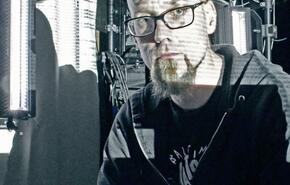
For over 20 years, Jeff Carey has performed synthetic noise music with a physically controlled software based instrument of his own development called ctrlKey. He is an avid electro-instrumental improvisor and is a composer of multichannel acousmatic music. His music is abstract and sculptural, full of shapes and gesture, colored by noise bursts, percussive glitches and shifting resonance. His work often incorporates extramusical elements like strobe lights, lasers and computer animation all… more
Jump to a project:
Visual Music: Precursor to Hypercube, Prototype for Movement with Feedback, Live performance
Prototype for Movement with Feedback, 2021
Prototype for Movement with Feedback is a composition for motion and sound — it is a cybernetic dance piece for moving light fixtures and electro-instrumental music. The piece uses synthetic sound and algorithmically controlled movement, yet it is imbued with personality and a human quality of communication through gesture and embodiment of sound. Premiered on The Fuse Factory’s Frequency Friday concert series in May 2021.
Precursor to Hypercube, 2017 Precursor to Hypercube is an immersive music installation that hovers between a thrill ride and a fever dream. Inspired by the mathematical concept of a 4-dimensional square, known as a hypercube, the composition explores the notion of multi-dimensional sound by articulating musical phrases physically and visually. Seat-belted into sound activated chairs, holding a panic button, wearing headphones in a darkened room, visitors hear, see and feel a composition that is articulated by synthesized sound, strobe and laser lighting. Heightened by the effect of active seating, sound transmits through visitors bodies, and the experience becomes totally visceral. Strobes flash and beams of laser light fill the field of vision. Precursor to Hypercube was made with support from the Greater Baltimore Cultural Alliance Rubys Artist Grant program and Recombinant Media Labs. Premiered at Recombinant Festival 2017.
Live Performance
These video excerpts from 2009-2018 feature the use of electro-instrumentally controlled strobe light arrays and laser projections.
Precursor to Hypercube, 2017 Precursor to Hypercube is an immersive music installation that hovers between a thrill ride and a fever dream. Inspired by the mathematical concept of a 4-dimensional square, known as a hypercube, the composition explores the notion of multi-dimensional sound by articulating musical phrases physically and visually. Seat-belted into sound activated chairs, holding a panic button, wearing headphones in a darkened room, visitors hear, see and feel a composition that is articulated by synthesized sound, strobe and laser lighting. Heightened by the effect of active seating, sound transmits through visitors bodies, and the experience becomes totally visceral. Strobes flash and beams of laser light fill the field of vision. Precursor to Hypercube was made with support from the Greater Baltimore Cultural Alliance Rubys Artist Grant program and Recombinant Media Labs. Premiered at Recombinant Festival 2017.
Live Performance
These video excerpts from 2009-2018 feature the use of electro-instrumentally controlled strobe light arrays and laser projections.
-
Precursor to Hypercube by Jeff CareyPrecursor to Hypercube is an immersive music installation that hovers between a thrill ride and a fever dream. Inspired by the mathematical concept of a 4-dimensional square, known as a hypercube, the composition explores the notion of multi-dimensional music by articulating musical phrases physically and visually. Precursor to Hypercube was made with support from the Greater Baltimore Cultural Alliance Rubys Artist Grant program and Recombinant Media Labs. Premiered at Recombinant Festival 2017. Seat-belted into bass activated chairs, holding a panic button, wearing headphones in a darkened room, visitors hear, see and feel a composition that is articulated by synthesized sound, strobe and laser lighting. Heightened by the effect of transducers on the seating, sound transmits through visitors bodies, and the experience becomes totally visceral. Strobes flash and beams of laser light fill the field of vision.
-
Active seating design for Precursor to HypercubeActive seating design for Precursor to Hypercube. Seatbelt, headphones, headphone amp for volume control, two SubPac subwoofers (bass for your body) on the seat and back of the chair, and a panic button.
-
Precursor to HypercubeStill image of Precursor to Hypercube from the audience perspective.
-
Precursor to HypercubeStill image of Precursor to Hypercube from the audience perspective.
-
Precursor to HypercubeStill image of Precursor to Hypercube from the audience perspective.
-
Precursor to HypercubeStill image of Precursor to Hypercube from the audience perspective.
-
Prototype for Movement with FeedbackPrototype for Movement with Feedback is a composition for motion and sound. It is a cybernetic dance piece for moving light fixtures and electro-instrumental music. The piece uses synthetic sound and algorithmically controlled movement, yet it is imbued with personality and a human quality of communication through gesture and embodiment of sound. Premiered on The Fuse Factory’s Frequency Friday concert series in May 2021.
-
Jeff Carey performance excerpts 2009-2018These video excerpts from 2009-2018 feature the use of electro-instrumentally controlled strobe light arrays and laser projections.
Electro-instrumental development: ctrlKey, DDrum, Now/Soon/Gone, Lemuria
ctrlKey
The electro-instrument ctrlKey is a custom designed gesturally controlled software synthesis and mapping system created by Jeff Carey and used in all of his performative work. The instrument's physically controlled sound development capabilities are flexible enough to make rapid changes between varied sound. It is a meta-instrument that allows the performer to, in a flexible way, direct the sound generation process and control extramusical elements like strobe lights, laser projectors and computer animation.
Soon/ Now/ Gone
Fabricate controllers, integrate hardware and code synthesizer instruments using Raspberry PI computers with Teensy controller boards and Supercollider in support of Erik Ruin and Rosie Langabeer installation at Site/Sound in Philadelphia.
Lemuria
Develop sound tranformation processing for acoustic quartet Lemur in the SuperCollider programming language. Four Raspberry PI based control stations for each instrumentalist are fed into a central computer for audio processing. Performers are spread out in large spaces and the sound is multichannel surround.
DDrum
Develop sound transformation processing of drum kit for Swiss percussionist Nicolas Field. DDrum uses triggers and microphones to capter and analyze drum sounds and synthesis material in response to, and under the control of the drummer.
The electro-instrument ctrlKey is a custom designed gesturally controlled software synthesis and mapping system created by Jeff Carey and used in all of his performative work. The instrument's physically controlled sound development capabilities are flexible enough to make rapid changes between varied sound. It is a meta-instrument that allows the performer to, in a flexible way, direct the sound generation process and control extramusical elements like strobe lights, laser projectors and computer animation.
Soon/ Now/ Gone
Fabricate controllers, integrate hardware and code synthesizer instruments using Raspberry PI computers with Teensy controller boards and Supercollider in support of Erik Ruin and Rosie Langabeer installation at Site/Sound in Philadelphia.
Lemuria
Develop sound tranformation processing for acoustic quartet Lemur in the SuperCollider programming language. Four Raspberry PI based control stations for each instrumentalist are fed into a central computer for audio processing. Performers are spread out in large spaces and the sound is multichannel surround.
DDrum
Develop sound transformation processing of drum kit for Swiss percussionist Nicolas Field. DDrum uses triggers and microphones to capter and analyze drum sounds and synthesis material in response to, and under the control of the drummer.
-
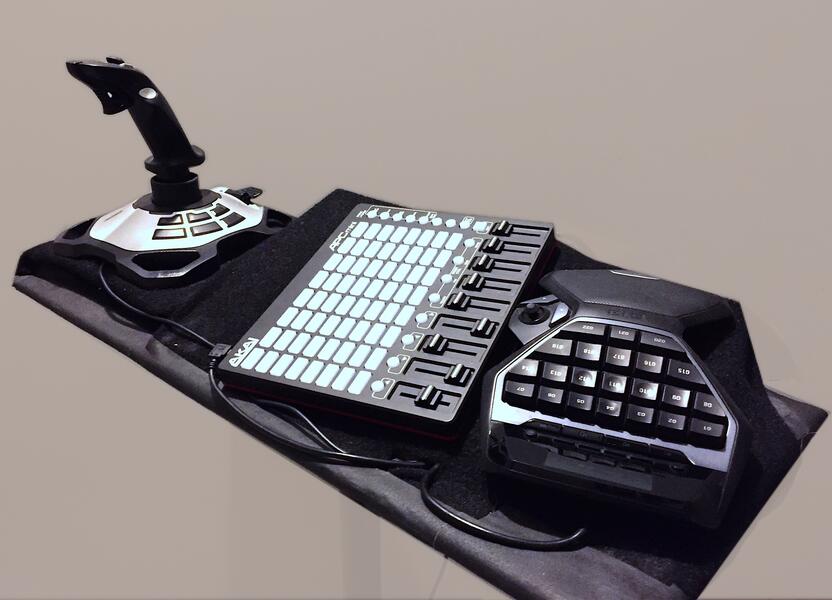 Electro-instrument ctrlKeyHardware interface for the electro-instrument "ctrlKey". These hardware elements send gestural control data to the mapping and synthesis software. Generally, the gamer key pad is used to start synthesis and algorithmic processes that make sound, the joystick is used to shape the sound. Buttons and faders in the center are used to select sound transformations, scenes, signal routing and to set parameters that have a global influence on the output. Both the joystick and the keypad have a hatswitch that allows both thumbs to have expressivity control.
Electro-instrument ctrlKeyHardware interface for the electro-instrument "ctrlKey". These hardware elements send gestural control data to the mapping and synthesis software. Generally, the gamer key pad is used to start synthesis and algorithmic processes that make sound, the joystick is used to shape the sound. Buttons and faders in the center are used to select sound transformations, scenes, signal routing and to set parameters that have a global influence on the output. Both the joystick and the keypad have a hatswitch that allows both thumbs to have expressivity control. -
 A code fragment from ctrlKeyA fragment selected from the thousands of lines of code that define the software component of "ctrlKey" electro-instrument. The software is written so that the gestural control is mapped to sound synthesis in a flexible way and can be changed while in performance to support needs that may only be discovered in the musical moment. This particular code snippet creates the ability for sound generators to receive data through custom mappings from control sources.
A code fragment from ctrlKeyA fragment selected from the thousands of lines of code that define the software component of "ctrlKey" electro-instrument. The software is written so that the gestural control is mapped to sound synthesis in a flexible way and can be changed while in performance to support needs that may only be discovered in the musical moment. This particular code snippet creates the ability for sound generators to receive data through custom mappings from control sources. -
"Chop Chop""Chop Chop" was written in 2010 for a 16 channel array of speakers in a ring. It is an electro-instrumental work for gesturally controlled computer with custom software. The control system guides synthesis procedures, algorthimically generated events and the spatialization of the sounds. The composition and development of custom software was made with support from the Bergen Kommune, Norway. Premiered at Ekko Festival October 2010. This recording is a stereo documentary recording without spatialization.
-
Matmos presents Jeff Carey live at Supersonic Festival 2014Excerpt of concert footage from the 2014 Supersonic Festival in Birmingham, UK.
-
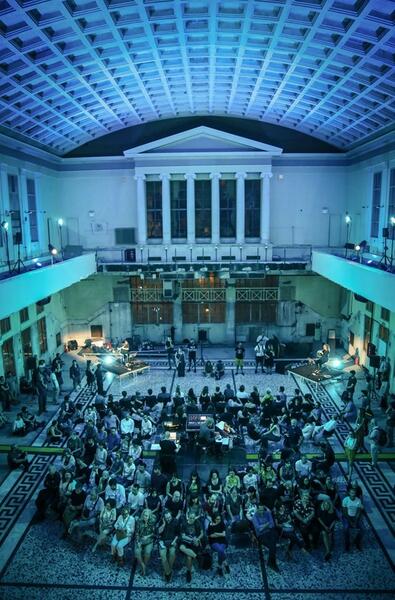 Lemuria in concert, Tectonics Festival, Athens Greece, 2019Lemuria, by Lemur in concert, Tectonics Festival, Athens Greece, 2019 Develop sound tranformation processing for acoustic quartet Lemur in the SuperCollider programming language. Four Raspberry PI based control stations for each instrumentalist are fed into a central computer for audio processing. Performers are spread out in large spaces and the sound is multichannel surround.
Lemuria in concert, Tectonics Festival, Athens Greece, 2019Lemuria, by Lemur in concert, Tectonics Festival, Athens Greece, 2019 Develop sound tranformation processing for acoustic quartet Lemur in the SuperCollider programming language. Four Raspberry PI based control stations for each instrumentalist are fed into a central computer for audio processing. Performers are spread out in large spaces and the sound is multichannel surround. -
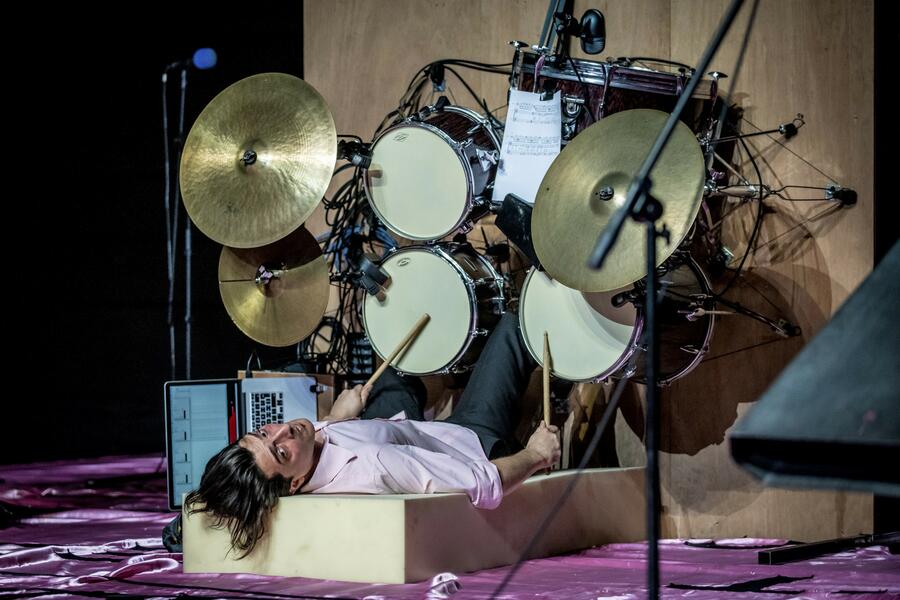 Nicolas Field and DDrumNicolas Field and DDrum developed by Jeff Carey Develop sound transformation processing of drum kit for Swiss percussionist Nicolas Field. DDrum uses triggers and microphones to capter and analyze drum sounds and synthesis material in response to, and under the control of the drummer.
Nicolas Field and DDrumNicolas Field and DDrum developed by Jeff Carey Develop sound transformation processing of drum kit for Swiss percussionist Nicolas Field. DDrum uses triggers and microphones to capter and analyze drum sounds and synthesis material in response to, and under the control of the drummer. -
Site/Sound: Soon/ Now/ GoneSoon/ Now/ Gone engages with the Rail Park site’s history as a space for movement through a series of interactive installations and performances. Our point of departure is the Victorian era, where technologies such as the railroad and photography/cinema began to be used as a way to capture, collapse, and re-deploy time. In various tunnels and underpasses beneath the Viaduct section of the Rail Park, audiences will be invited to activate zoopraxiscopes—a pre-cinema device developed by Eadweard Muybridge in 1879—which will project hand-drawn images from rotating glass disks in rapid succession to create the illusion of motion. Each zoopraxiscope is fitted with a music device that visitors can use to activate an original soundtrack composed for the installation. By turning on and off different strains of the music and triggering sound effects, they will be able to create their own scores to the moving images on the tunnel wall.
-
 Zoopraxiscope sound controller for Soon/ Now/ GoneZoopraxiscope sound controller for Soon/ Now/ Gone Green buttons on the left select a scene of sounds that appear on the yellow buttons. Yellow buttons start and stop sounds while knobs modify the sounds in some way. The interface is a device that allows for surprise, exploration and development of sounds to accompany the hand made Zoopraxiscope visuals.
Zoopraxiscope sound controller for Soon/ Now/ GoneZoopraxiscope sound controller for Soon/ Now/ Gone Green buttons on the left select a scene of sounds that appear on the yellow buttons. Yellow buttons start and stop sounds while knobs modify the sounds in some way. The interface is a device that allows for surprise, exploration and development of sounds to accompany the hand made Zoopraxiscope visuals. -
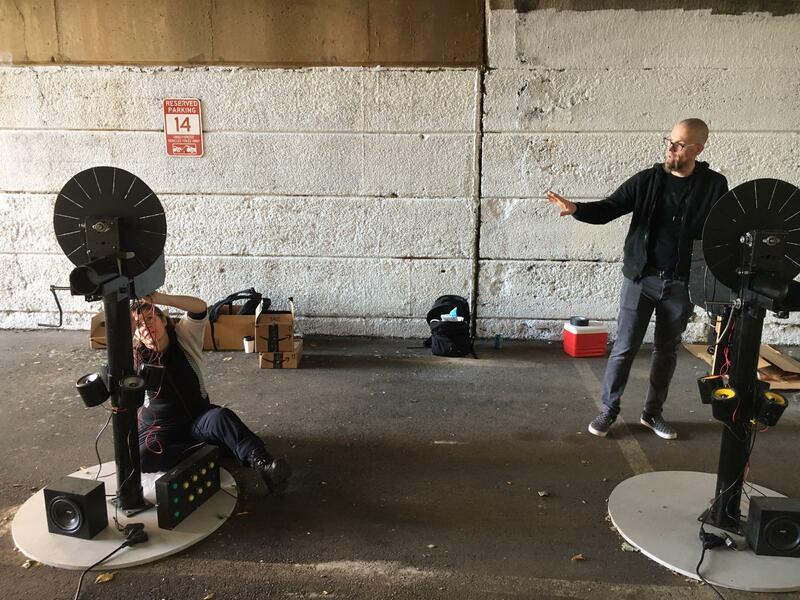 Installing the Zoopraxiscopes at Soon/ Now/ Gone with Rosie Langabeer and Jeff CareyTwo Zoopraxiscopes in the process of installation. Each station has a hand cranked Zoopraxiscope that projects a short hand drawn film by Erik Ruin and a sound controller that plays sound material composed by Rosie Langabeer. The controllers and Raspberry PI based synthesis software and sounds precessing were developed but Jeff Carey.
Installing the Zoopraxiscopes at Soon/ Now/ Gone with Rosie Langabeer and Jeff CareyTwo Zoopraxiscopes in the process of installation. Each station has a hand cranked Zoopraxiscope that projects a short hand drawn film by Erik Ruin and a sound controller that plays sound material composed by Rosie Langabeer. The controllers and Raspberry PI based synthesis software and sounds precessing were developed but Jeff Carey.







